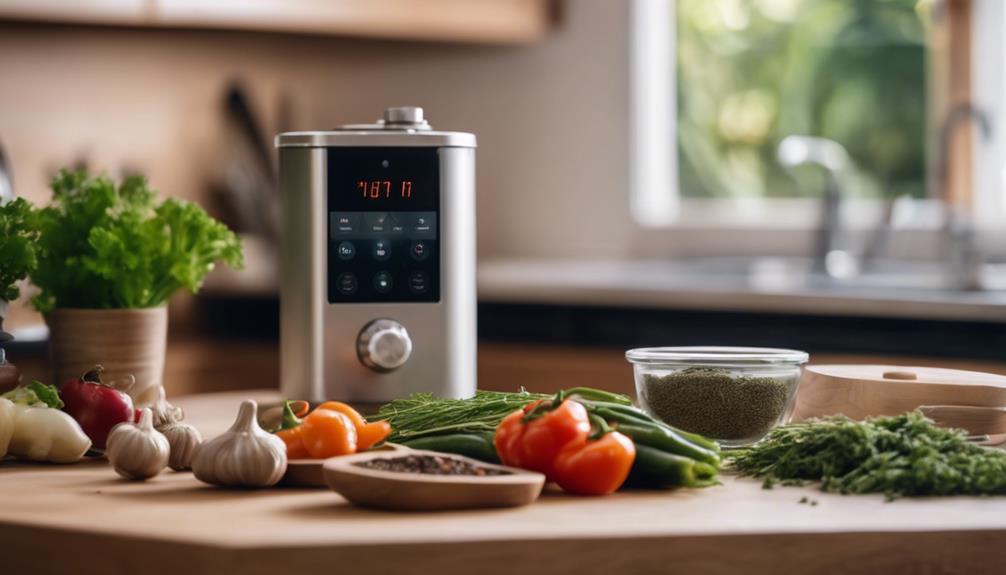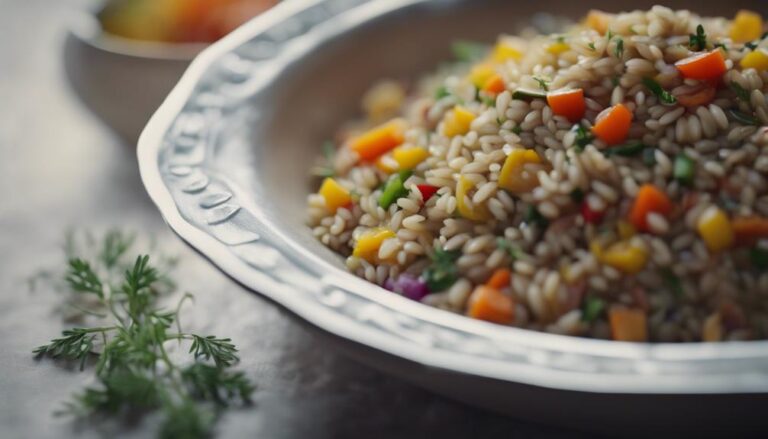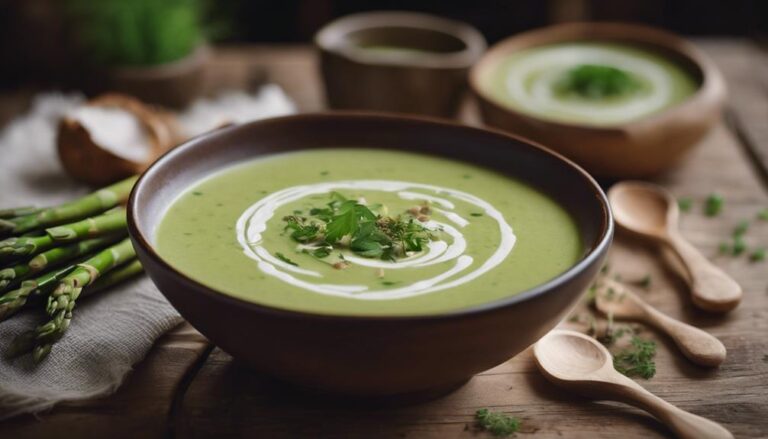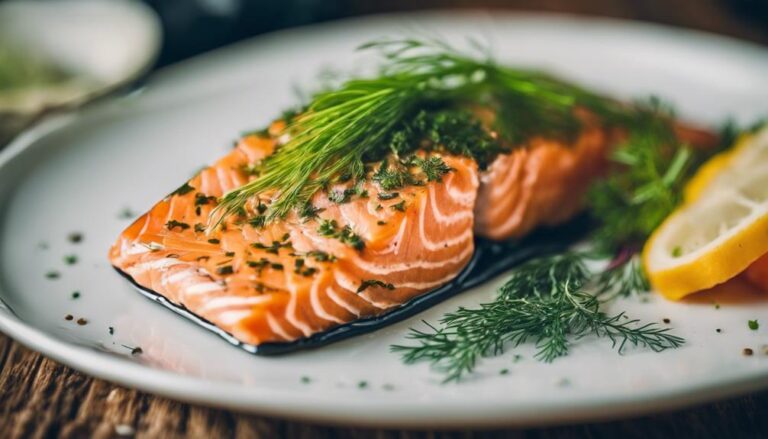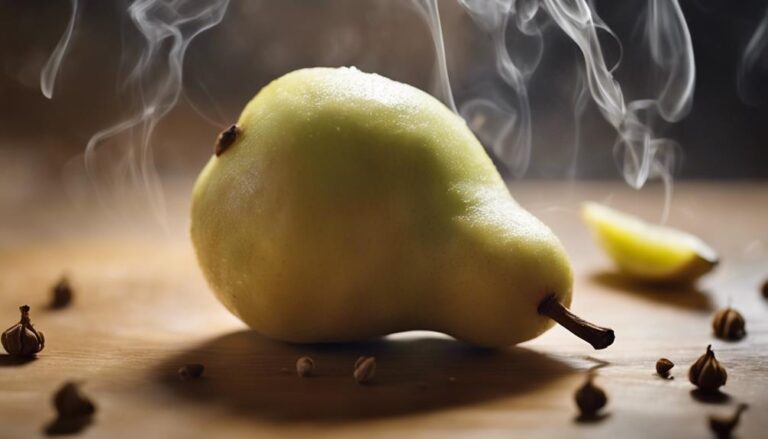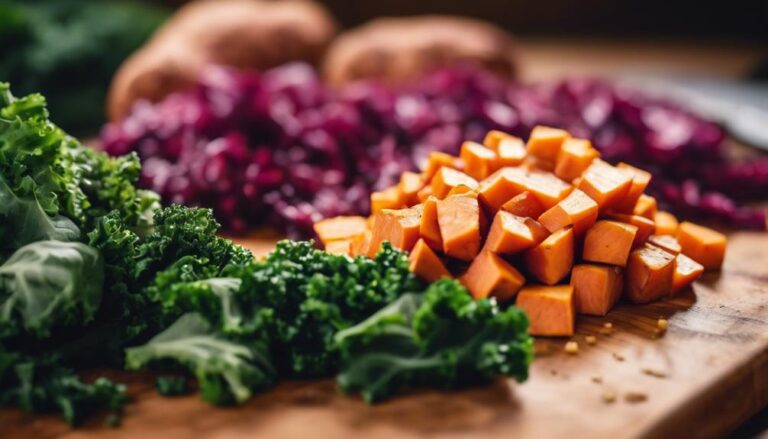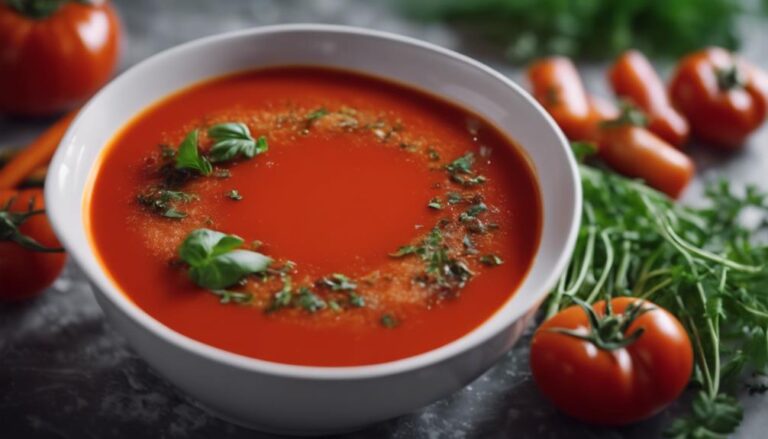Harmonizing Health: Embracing the Ancient Wisdom of the Ayurvedic Diet With Sous Vide Cooking
You can harmonize your health by blending the ancient wisdom of the Ayurvedic diet with the precision of sous vide cooking. Ayurveda focuses on balancing your doshas – Vata, Pitta, and Kapha – through tailored nutrition, integrating superfoods that align with your personal wellness needs. Sous vide cooking complements this by precisely maintaining temperature, which preserves the nutrients and enhances the flavors of these beneficial ingredients. This method secures that the therapeutic properties of Ayurvedic spices are retained, optimizing your meal's nutritional value. Exploring beyond these basics could transform your approach to health and well-being.
What You Will Learn Here
- Sous vide cooking preserves the therapeutic properties of Ayurvedic spices, enhancing health benefits.
- Precise temperature control in sous vide cooking maintains the integrity and potency of Ayurvedic ingredients.
- Combining sous vide techniques with the Ayurvedic diet supports personalized nutrition and dosha balance.
- Ayurvedic sous vide meals optimize nutrient retention, aligning with holistic health principles.
- This cooking method infuses flavors while preserving natural textures, elevating the sensory quality of Ayurvedic meals.
Understanding Ayurveda Basics
Understanding Ayurveda begins with recognizing its core concept: the balance of the three doshas—Vata, Pitta, and Kapha—which are distinct energy types that influence individual health and well-being. Each dosha embodies unique characteristics and governs specific bodily functions, steering your holistic well-being. Vata, characterized by qualities of air and space, dictates movement and flexibility. Pitta, representing fire and water, oversees metabolism and digestion. Kapha, made of earth and water, imparts strength and stability.
To maintain or restore health, Ayurvedic principles emphasize dietary harmony tailored to your dominant dosha. This personalized nutrition approach ensures that the food you consume synergistically aligns with your unique energy composition. By understanding the Ayurvedic elements inherent in various foods, you can select ingredients that balance rather than aggravate your doshas. For instance, cooling foods may benefit a Pitta-dominant person, while warming spices might be better for balancing Vata.
Implementing these principles doesn't just cater to physical health but also nurtures mental and spiritual well-being, presenting a truly holistic approach to living. This integration of body, mind, and spirit through targeted dietary choices helps in achieving not just temporary relief from ailments but a sustained state of health and vitality.
Thus, as you explore further into Ayurveda, you'll appreciate how this ancient wisdom can be adapted to modern needs, promoting longevity and enhanced life quality through the thoughtful convergence of diet and dosha. This journey towards holistic well-being isn't only about feeding the body but also about nourishing the soul and fostering a deeper connection with oneself.
Identifying Your Dosha
To maximize the benefits of Ayurvedic principles in your life, you'll first need to identify your dominant Dosha. Understanding your unique combination of Vata, Pitta, and Kapha energies is essential. Each Dosha has specific characteristics that influence your physical, emotional, and mental well-being. For instance, Vata is linked with qualities of air and space, making Vata individuals energetic but often prone to dry skin and anxiety when imbalanced. Pitta, associated with fire and water, typically leads to a fiery personality and an efficient metabolism, yet can cause irritability and inflammation if not balanced. Kapha, rooted in water and earth, often manifests as strength and endurance but can lead to weight gain and lethargy when out of sync.
To determine which Dosha predominates in you, taking a Dosha quiz can be highly insightful. These quizzes assess your physical features, metabolism, and temperament to help pinpoint your Ayurvedic constitution. This recognition is the first step toward Dosha healing, allowing for a more tailored approach to diet and lifestyle that harmonizes your internal state.
Further, integrating Dosha meditation into your routine can enhance this personalized healing process. By focusing on specific meditative practices that align with your Dosha, you can promote mental clarity and emotional stability, effectively addressing any Dosha imbalance.
Embracing these facets of Ayurvedic wisdom not only nurtures your body but also cultivates a deeper connection with the needs of those around you, fostering a supportive and understanding environment for everyone involved.
Principles of the Ayurvedic Diet
Begin your journey to balanced health by exploring the principles of the Ayurvedic diet, which tailors nutrition to your unique Dosha composition. Understanding how to harmonize your Vata, Pitta, or Kapha through dietary choices is crucial to achieving Ayurvedic harmony. Each Dosha requires different nutritional strategies to maintain balance, such as warm, grounding foods for Vata, cooling selections for Pitta, and light, stimulating options for Kapha.
Mindful eating is a cornerstone of the Ayurvedic diet, emphasizing the importance of how you eat, not just what you eat. It's about being present with your meals, eating slowly, and savoring each bite to enhance digestive wellness and absorption of nutrients. This practice supports your digestive fire or Agni, which is essential for transforming food into energy and maintaining robust health.
Superfood integration is another key aspect. Ayurvedic superfoods—like turmeric, ginger, and amalaki—are incorporated based on their properties to heal and nourish the body while supporting Dosha balancing. These superfoods help in detoxifying, rejuvenating, and boosting immunity, aligning perfectly with the goal of nurturing your body holistically.
Introduction to Sous Vide Cooking
Exploring sous-vide cooking reveals its power to precisely control temperature, guaranteeing your food retains its natural flavors and nutrients. This method involves vacuum-sealing your ingredients in a plastic bag and submerging them in a water bath set to a consistently accurate temperature. This precision in temperature control is vital, particularly when you're aiming to marry the holistic benefits of an Ayurvedic diet with modern culinary techniques.
Sous vide techniques stand out for their ability to maintain the integrity of food. By cooking at lower temperatures, typically between 65-95°C, you're equipped to achieve flavor infusion without risking the overcooking that can so often diminish your dish's nutritional value and taste. The gentle and steady temperature ensures that the spices and herbs you use, integral to Ayurvedic practices, release their full spectrum of flavors and health benefits into the food, without being degraded by excessive heat.
Moreover, the nutrient retention facilitated by sous vide cooking is unparalleled. Since the food is contained within a sealed environment, there's minimal loss of vitamins and minerals to water, as often occurs in traditional boiling or steaming methods. This aspect is particularly beneficial if you're focused on serving meals that support health and wellness.
Lastly, the cooking precision offered by sous vide allows you to replicate dishes with consistent quality, which is especially important when preparing meals that require a balance of flavors, as prescribed in Ayurvedic nutrition. Whether you're a home cook or a professional chef, integrating sous vide into your culinary practices ensures that every meal serves not just the body, but also the soul.
Benefits of Sous Vide for Nutrition
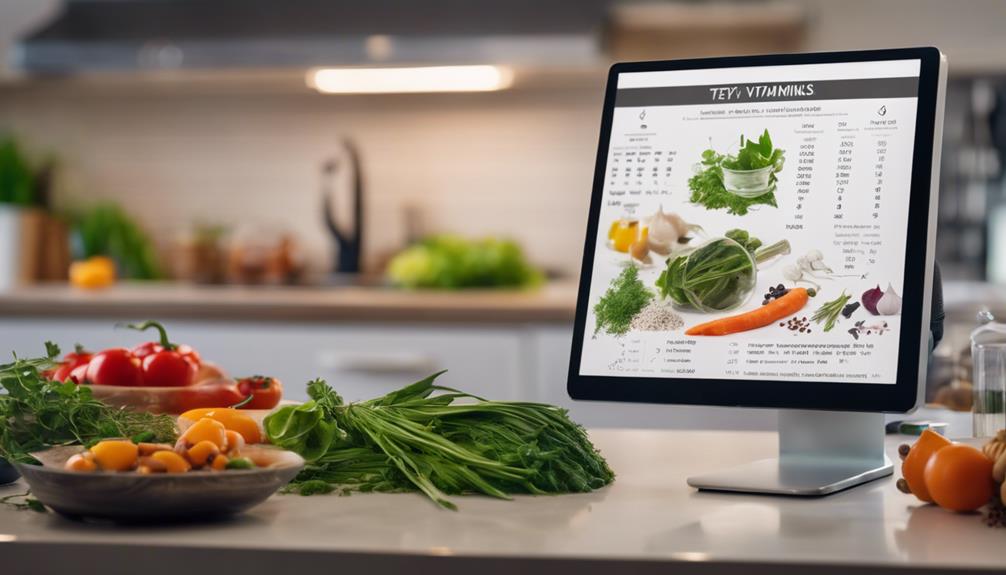
Why should you consider sous-vide cooking to boost the nutritional quality of your meals? This innovative cooking method excels in nutrient retention, guaranteeing that the health benefits of your food are optimized. By cooking ingredients in a vacuum-sealed bag at precisely controlled temperatures, sous-vide prevents the loss of vitamins and minerals that commonly occurs with traditional cooking methods.
The precise temperature control inherent in sous-vide cooking not only preserves nutrients but also enhances the natural flavors of the ingredients. This flavor enhancement means you're less likely to reach for unhealthy additives like excessive salt or fat to make your meals taste better. It's a natural way to please your palate while caring for your body.
Moreover, the gentle cooking process reduces oxidation, which is often responsible for the degradation of essential nutrients. Oxidation prevention is particularly beneficial when cooking foods rich in fats and oils, safeguarding their healthful properties and preventing the formation of harmful compounds.
The integration of sous-vide in your cooking routine can be a game-changer, especially when you're aiming to serve meals that support holistic well-being. The method's ability to maintain the integrity and potency of food's nutritional content aligns perfectly with the Ayurvedic principle of nourishing the body wholesomely.
Thus, embracing sous-vide cooking not only elevates the sensory qualities of your dishes but also ensures that every meal you serve contributes positively to the health and vitality of those you care for. This blend of cooking precision and nutritional preservation makes sous-vide an invaluable tool in the quest for a balanced, health-focused diet.
Planning Ayurvedic Sous Vide Meals
To initiate Ayurvedic sous vide meals effectively, you'll need to select ingredients that balance your Doshas while utilizing precise temperature controls to preserve their nutritional value. This approach not only enhances the meal's health benefits but also guarantees that each dish is customized to suit individual wellness needs.
When starting on meal preparation, consider the impact of each ingredient on Vata, Pitta, and Kapha, the three Doshas in Ayurveda. Each Dosha responds differently to various foods, so ingredient selection is paramount. You're not just cooking; you're curating a personalized health experience for yourself or those you're serving. Incorporating sous vide cooking into this process allows for unparalleled temperature control, ensuring that the ingredients retain their potent qualities without overcooking, which can diminish their efficacy.
Furthermore, sous vide's ability to maintain a consistent temperature is essential for dosha balancing. This method avoids the high heats that can destabilize the vital properties of some ingredients. Instead, it gently coaxes out flavors and integrates them throughout the dish, achieving a flavor infusion that's both subtle and profound.
As you plan your meals, focus on how the temperatures align with the energy properties of the ingredients. For instance, certain spices may need a slightly higher temperature to release their full spectrum of flavors and therapeutic benefits. By mastering these elements, your Ayurvedic sous vide meals won't only nourish but also delight, offering a truly holistic approach to wellness.
Ayurvedic Ingredients and Sous Vide
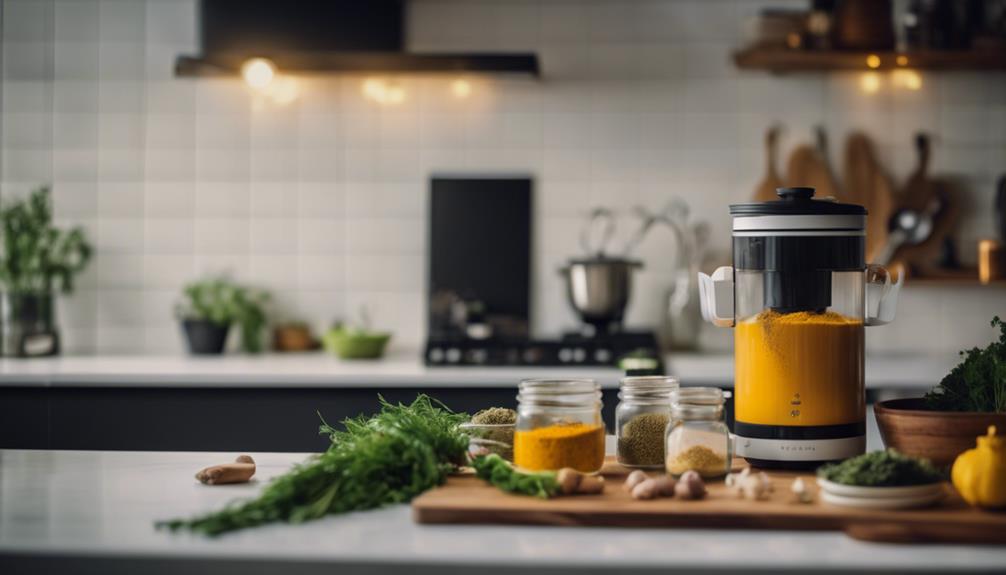
Now let's examine how specific Ayurvedic ingredients can be ideally cooked using sous vide techniques to enhance their health benefits. By utilizing the precision of sous vide cooking, you can maximize the nutrient absorption of these potent ingredients. This method cooks at low temperatures over extended periods, allowing Ayurvedic spices and herbs to release their full spectrum of medicinal properties without the degradation that high heat can cause.
For instance, turmeric, renowned for its anti-inflammatory effects, can be sous vide along with coconut oil to create a powerful concoction. The controlled temperature of sous vide ensures that turmeric's curcumin retains its anti-inflammatory potency. This method also aids in the infusion of flavors, making the spice not only a healthful addition but also enhancing the overall taste of the dish.
Similarly, ginger, which is used in Ayurveda for its digestive and anti-inflammatory properties, can be finely sliced and cooked sous vide with a touch of honey and lemon. This combination not only preserves the essential oils responsible for ginger's benefits but also guarantees a deep flavor infusion that's both zesty and soothing.
In essence, sous vide techniques allow you to cook Ayurvedic ingredients such as herbs and spices in a way that preserves and amplifies their health benefits. The gentle cooking process of sous vide prevents the loss of essential oils and nutrients, ensuring that what you serve is as nourishing as it's delicious. By embracing these methods, you're not just cooking; you're enhancing wellness with every dish.
Combining Flavors and Textures
Sous-vide cooking perfectly preserves the natural essence of Ayurvedic ingredients, enhancing both their flavors and textures in your dishes. This technique allows you to master the art of flavor fusion and texture balance, critical in Ayurvedic cuisine, which aims to cater to all senses, promoting a holistic dining experience. By cooking ingredients at precise temperatures, sous-vide guarantees that the natural flavors aren't only retained but also intensified, allowing for a more profound taste harmony and culinary synergy in every bite.
When you're practicing ingredient pairing, consider the Ayurvedic concept of combining the six tastes: sweet, sour, salty, bitter, pungent, and astringent. Sous-vide makes it easier to achieve this balance, as it gently coaxes out these flavors, ensuring they meld seamlessly without overpowering each other. For instance, pairing sweet carrots with pungent ginger can create a harmoniously flavored dish where neither taste overshadows the other.
Moreover, the controlled environment of sous-vide cooking means that textures are impeccably consistent. This consistency is important in Ayurveda, where the feel of food can impact digestion and overall health. Whether you're aiming for the crunch of lightly cooked vegetables or the tenderness of perfectly cooked grains, sous-vide delivers with precision.
Embrace this modern culinary technique to enhance your Ayurvedic cooking practices. You'll find that sous-vide not only respects but elevates the ancient wisdom encapsulated in each ingredient, bringing forth a symphony of flavors and textures that nourish both body and soul.
Everyday Ayurvedic Sous Vide Recipes
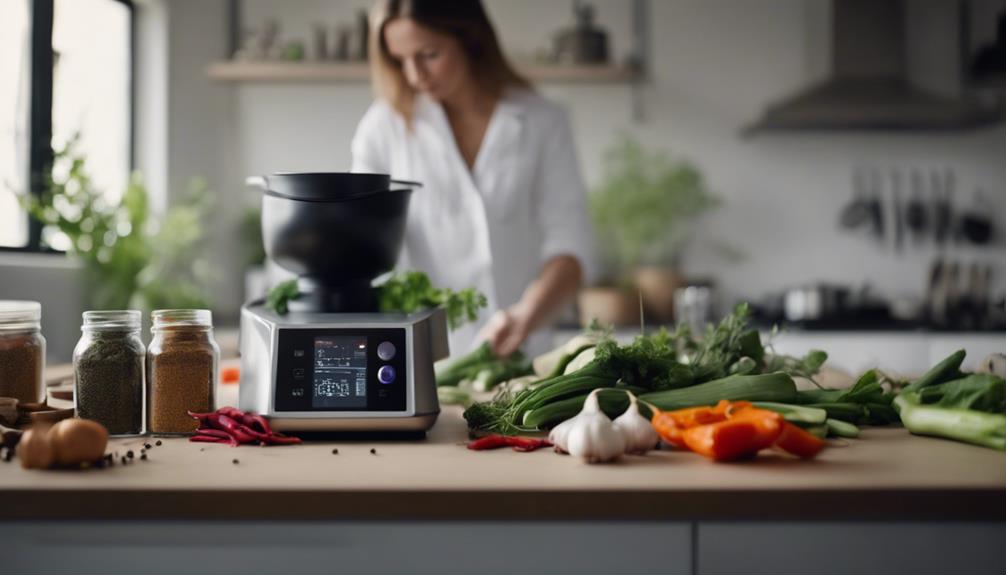
Building on the harmonious blend of flavor and texture from sous-vide cooking, let's explore how everyday Ayurvedic recipes can be adapted to this method for enhanced health benefits. By incorporating sous vide techniques into your cooking, you're not only preserving essential nutrients but also amplifying the natural flavors of Ayurvedic spices, which are crucial in balancing your doshas.
Consider the preparation of a simple turmeric and ginger chicken. Both spices are celebrated for their anti-inflammatory properties and aid in digestion optimization. When cooked sous vide, the chicken is infused deeply with these spices, ensuring each bite is packed with flavor and health benefits. Additionally, the gentle cooking process of sous vide ensures that the delicate nutrients and enzymes in Ayurvedic spices are preserved, not destroyed by high heat.
For vegetarians, a sous-vide beetroot curry can be transformative. Beetroots, rich in iron and vitamins, cooked with cumin and coriander in a sous vide bag, retain their vibrant color and nutrients, offering a visually appealing and nourishing meal. This method of cooking not only maintains the integrity of the ingredients but also enhances their inherent flavors, making your meal both satisfying and digestively harmonious.
As you continue to serve and nourish others, integrating these sous vide techniques with Ayurvedic principles can greatly uplift the nutritional profile of your dishes. You're ensuring that the food not only tastes good but also contributes positively to the body's health, promoting vitality and well-being with every meal.
Sustaining Health With Ayurveda and Sous Vide
By integrating Ayurvedic dietary practices with sous-vide cooking techniques, you can sustainably enhance your health and well-being. This unique combination allows for dosha balancing, a core principle of Ayurveda that aligns your body's natural elements through personalized nutrition. Using sous-vide, you can precisely control cooking temperatures, guaranteeing that these tailored meals not only nurture your specific health needs but also retain maximum nutrients.
Sous-vide's slow-cooking method encapsulates flavors and moisture, leading to a flavor infusion that can turn even simple ingredients into a vibrant, aromatic dish. This method meshes beautifully with Ayurvedic spices, which are pivotal in healing and preventive health care. The spices' therapeutic properties are preserved and even amplified in the vacuum-sealed environment of sous-vide cooking, exemplifying culinary alchemy where ancient wisdom meets modern technique.
Moreover, this fusion isn't just about taste. It's about nutrient optimization. Foods cooked sous-vide retain more vitamins and minerals than those cooked through traditional methods, which often involve high heat that can diminish nutritional content. By encapsulating food in airtight bags, sous-vide cooking guarantees that the food's integrity and health-enhancing properties are maintained.
This wellness fusion extends beyond physical health, influencing mental and spiritual well-being by harmonizing the body's rhythms and energies. Embracing this approach means you're not just cooking; you're curating a lifestyle that supports longevity, immunity, and harmony. You're engaging in a practice that serves others by nurturing body, mind, and spirit, setting a foundation for sustained health and vitality.
Frequently Asked Questions
What Food Should Be Avoided in Ayurveda?
You should avoid processed foods, refined sugars, cold beverages, artificial additives, and non-seasonal fruits in an Ayurvedic diet to maintain peak health and digestion while serving others nutritiously balanced meals.
What Is Ayurvedic Style of Cooking?
In Ayurvedic cooking, you'll use fresh ingredients and specific spices to support digestion. Meals are timed and cooked at precise temperatures to enhance both flavor and medicinal properties, nurturing your body holistically.
What Are the Healing Foods in Ayurveda?
In Ayurveda, healing foods balance Doshas and include seasonal ingredients, digestive spices, and herbal teas. You'll benefit from Ayurvedic fasting and integrating these practices to nourish and rejuvenate your body and mind.
Can You Eat Meat on an Ayurvedic Diet?
Yes, you can eat meat on an Ayurvedic diet. Choose Dosha-specific meats, opt for seasonal and ethically sourced options, and apply mindful meat preparation methods to enhance digestion and overall health.
Conclusion
Now that you've explored the synergy of Ayurveda and sous-vide, you're equipped to unleash the full potential of each ingredient in your meals.
By understanding your dosha and employing precise cooking techniques, you'll tap into the complete essence of every element.
Embrace this journey to blend ancient wisdom with modern culinary art. Start crafting dishes that not only please your palate but also promote your well-being.
Welcome to a revitalized way of eating where every meal enriches your health.
